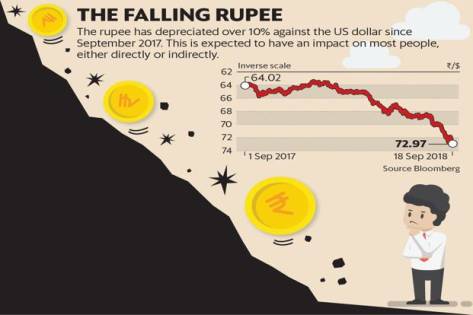
The Indian rupee, which has been depreciating against the US dollar over the past few weeks, touched and closed at an all-time low of 72.97 per US dollar on 18 September, down 0.63% from its previous day’s close at 72.51. A year ago, on 18 September 2017, one US dollar would get you ₹64.14.
The decline of about 13.7% in the value of rupee over a year will affect most of us, directly and indirectly. Here are the ways in which you could be impacted and some measures you can take to hedge against the risks.
Education abroad
For the 752,000 overseas Indian students, and particularly for the 210,000 students studying in the US, this is bad news. An Indian student in the US who paid fees at the exchange rate of around ₹65 per dollar in 2017, might end up paying around ₹71 per dollar this year. Considering that an Indian student spends about $50,000 a year on tuition and housing on average, this could mean an additional spending of ₹3 lakh. Rohan Ganeriwala, co-founder, Collegify, an education consultancy, said, on average, an Indian student studying in the US spends $40,000 to $70,000 per year, including tuition and housing.
According to the Reserve Bank of India, overseas education expenditure by Indians was $2.77 billion in 2017-18, which was about 5% higher than 2016-17.
Despite the fact that most people plan for foreign education in advance, a sudden depreciation of the rupee can catch most students and their sponsors off guard. While those who are already studying abroad will have to manage somehow, those who intend to go abroad for education in future should take notice. Vishal Dhawan, founder and CEO, Plan Ahead Wealth Advisors, said that apart from taking future inflation into account, parents also need to consider future rupee depreciation and plan accordingly.
“Over periods of time, depreciation will continue, as inflation in India tends to be higher than many parts of the world, especially the US. Those planning for a foreign education can cover a part of this risk by investing in international funds like feeder funds,” Dhawan said. Feeder funds are India-based funds, that invest in funds internationally.
Feeder funds could help you hedge against currency depreciation as the future returns could be in dollars. Gold can also play some role as a hedge, but ideally, your allocation to gold investments should not be above 5-10%.
Foreign travel
Just like students, rupee depreciation can hit those planning to travel abroad. In such a situation, about 25% travellers indicate that they might drop an optional tour while in a particular destination, said Rajeev Kale, president and country head, leisure travel and MICE, Thomas Cook (India) Ltd.
For those who have already planned travel to the US, readjustments like curtailing expenses on shopping, entertainment or dining will help. Those who are still in the planning stage should consider alternative destinations, considering the upside the rupee has against some other currencies like the UK pound, Canadian dollar, South African rand or New Zealand dollar. Kale said when the rupee depreciates, short-haul trips to destinations like Singapore, Malaysia, Thailand, Dubai, and Hong Kong see rising interest.
Fuel Prices
The other direct impact is fuel price as India is heavily dependent on imports for crude oil, and a depreciating rupee makes imports expensive. However, international oil prices also play a role in determining fuel prices.
Madan Sabnavis, chief economist at Care Ratings, said it is very clear that the government is not willing to reduce its duties for now or provide a subsidy on fuel. The price paid by a consumer includes taxes like the excise duty by the central government, sales tax or value added tax by state governments as well as dealer commission. Hence, unless the government reduces the taxes on fuel, consumers will be hit.
While you may not notice the impact of rising fuel prices on a daily basis, this effectively increases the amount you spend on fuel every month for the same amount of travel. Back-of-the-envelope calculations show that a person driving 900km a month in Mumbai in a petrol car could see her monthly fuel bills in September 2018 go up by about ₹1,400 as compared to September 2017, and about ₹2,000 from September 2016.
Kalpesh Ashar, a certified financial planner and founder, Full Circle Financial Planners and Advisors, said that based on his experiences with his clients, a family of four would spend approximately ₹5,000 to ₹7,000 on their personal vehicles each month. “This was before the recent price escalation. The spending on official transport or public transport is in addition to that. Travel cannot be stopped altogether, but people are being wary of the expenses for sure. Whatever the price, you cannot escape this part of spending,” he said.
Inflation and Interest rates
Rising fuel prices, in turn, increase the cost of transportation of various goods, from manufactured products to agricultural produce. This may affect the prices of your daily groceries.
Depreciating rupee could also lead to another interest rate hike by RBI, which has already raised interest rates twice this year. “We were expecting a 25 basis points interest rate hike in December, but it could even happen in October now,” Sabnavis said. A higher interest rate would mean higher EMIs. For investors of debt funds, rise in interest rates would bring down bond prices and hence debt funds’ net asset values (NAVs).
While we typically relate the exchange rate to international end-use, it can have an impact right here, in India, too. Hence, your investments have to be planned accordingly. Dhawan said there is a need for retail investors to use assets which are good inflation hedgers. Investing in equity over long periods of time as well as gold from a currency perspective could be helpful. But do keep your risk profile and asset allocation in mind before investing
Posted on :
Sep 19, 2018